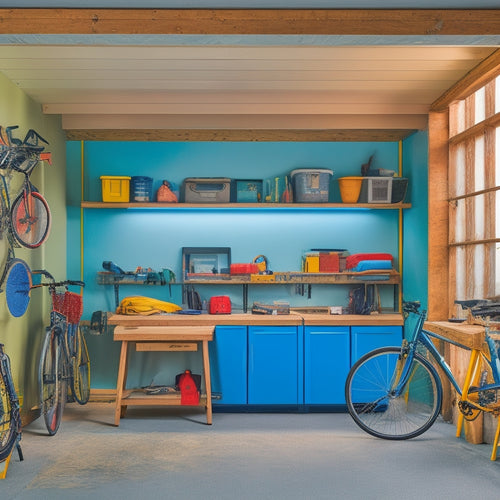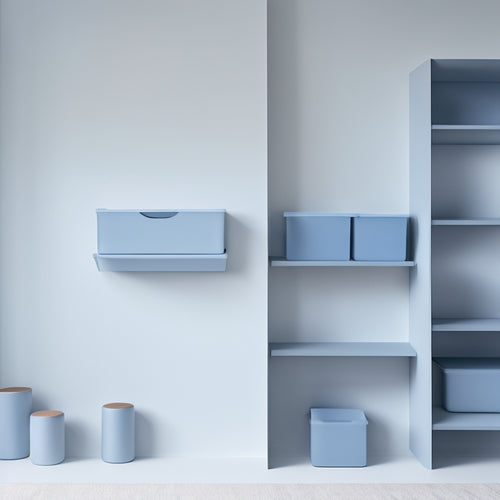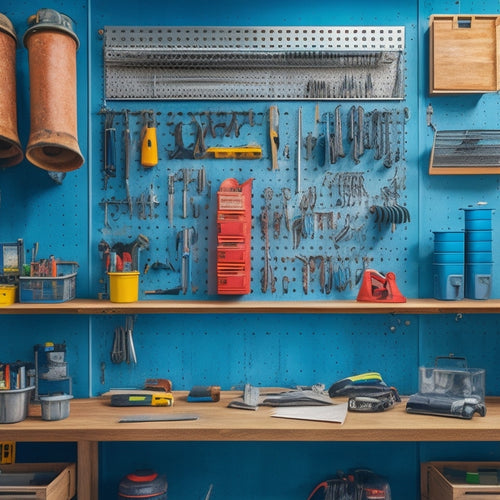
Design Your Dream Pegboard Layout Step-by-Step
Share
To design your dream pegboard layout, start by evaluating your tool collection, categorizing tools by function and frequency of use, and measuring your pegboard space. Identify essential tool zones, such as hand tool storage and power tool stations, and choose a layout style that reflects your personality and workspace. Plan power tool placement, incorporating small item storage and hooks for frequently used items. Visualize your design, considering flow, layout, and color scheme. By following these steps, you'll create a functional and efficient pegboard layout that boosts productivity. Now, take the next step to turn your vision into a reality.
Key Takeaways
• Assess your tool collection, categorizing hand and power tools, and prioritize based on frequency of use to optimize pegboard space.
• Measure pegboard dimensions and surrounding space precisely to create a standardized layout for tool compatibility and efficient use.
• Identify essential tool zones, including hand tool storage, power tool stations, and small item storage, to enhance convenience, efficiency, and safety.
• Choose a pegboard layout style that reflects your personality and complements your workspace, ensuring it enhances functionality and efficiency.
• Plan power tool placement strategically, considering accessibility, cord management, and workflow to prevent "Tool Traffic" and streamline your process.
Assess Your Tool Collection
Take stock of the tools you currently own, considering their size, frequency of use, and functionality to determine which ones will be pegboard-bound. This is the first step in designing your dream pegboard layout.
You'll want to categorize your tools into groups, such as hand tools, power tools, and accessories. Within each group, identify the tools you use most frequently and those that are less essential. This will help you prioritize which tools to place on the pegboard and which can be stored elsewhere.
Effective inventory management is important in this process. Take note of the tools you have duplicates of, and consider keeping only your favorites or the ones in the best condition. You might also identify tools that are no longer useful or have been replaced by newer models. Set these aside to donate, sell, or repurpose.
Measure Your Pegboard Space
When designing your dream pegboard layout, it's crucial to measure your pegboard space accurately. You'll need to take precise measurements of the pegboard's dimensions, as well as the space around it, to guarantee a perfect fit.
Pegboard Dimensions Matter
You'll work more efficiently by defining your pegboard's dimensions before arranging tools, as a well-planned layout hinges on accurately measuring the space available. This critical step guarantees that your tools fit comfortably and are easily accessible. To get started, take note of your pegboard's material, as this affects the type of hooks and accessories you can use. For instance, a wooden pegboard may require different hooks than a metal one.
When measuring your pegboard, consider the following factors:
| Factor | Description | Importance |
|---|---|---|
| Width | Distance from left to right edge | High |
| Height | Distance from top to bottom edge | High |
| Thickness | Depth of the pegboard | Medium |
| Hole Pattern | Spacing and arrangement of holes | High |
Standardization is key when it comes to pegboard dimensions. A standardized layout ensures that your tools are compatible with the pegboard, making it easier to swap them out or add new ones. By accurately measuring your pegboard's dimensions, you'll create a functional and efficient layout that maximizes your workspace.
Space Measurement Tools
Your measuring tape becomes an essential ally as you begin accurately pinpointing the dimensions of your pegboard, ensuring a precise fit for your tools and accessories.
With precision calibration, you'll eliminate the risk of miscalculations, guaranteeing a seamless integration of your gear.
Start by measuring the width, length, and height of your pegboard, taking note of any obstructions or irregularities.
Next, use a laser alignment tool to create a precise grid, allowing you to visualize your layout and make informed decisions about tool placement. This step is important, as it will determine the overall functionality and efficiency of your pegboard.
Take your time, and don't rush through the measurement process – accuracy is key.
With your dimensions recorded and grid in place, you'll be well on your way to designing a pegboard that meets your specific needs and workflow.
Accurate Pegboard Mapping
Measure the pegboard space by recording the distance between each hook, slot, or other anchor point, ensuring an accurate map of available space for tool placement. This step is critical in designing your dream pegboard layout.
Take out your measuring tape and carefully record the measurements, making note of any obstructions or irregularities on the board.
Next, transfer your measurements onto a digital template or graph paper. This will give you a visual representation of your pegboard space, allowing you to plan your layout with precision.
Consider using custom icons or symbols to represent each tool or accessory, making it easier to visualize your design. Be meticulous in your mapping, as this will guarantee a seamless shift from design to reality.
Identify Essential Tool Zones
Now that you've measured your pegboard space, it's time to identify the essential tool zones that will make your workspace efficient.
You'll want to create areas for tool organization, hand tool storage, and a power tool station to guarantee everything has its designated spot.
Tool Organization Strategy
Identify the tasks you perform most frequently and group the required tools into essential zones, ensuring each zone is dedicated to a specific function or category. This strategy will help you create a pegboard layout that supports your workflow and maximizes efficiency.
By categorizing your tools into distinct zones, you'll reduce clutter, save time, and increase productivity.
Here are some essential zones to take into account:
-
Power tools: Group drills, saws, and other power tools together for easy access when working on projects.
-
Fasteners and fixings: Store screws, nails, and other fasteners in a dedicated zone for quick retrieval.
-
Measurement and testing: Designate an area for measuring tools, such as calipers and levels, and testing equipment, like multimeters.
- Miscellaneous: Create a catch-all zone for tools that don't fit into other categories, like pliers, wrenches, and hand saws.
Hand Tool Storage
You'll need to allocate specific zones on your pegboard for hand tools, which can be broadly categorized into gripping, cutting, and striking tools. These zones will help you maintain a clutter-free workspace and reduce the time spent searching for tools.
Start by designating areas for frequently used tools like pliers, wrenches, and screwdrivers. Consider grouping tools by function, such as all cutting tools together, to enhance your workflow.
When organizing your hand tools, think about the tools you use most often and allocate prime real estate on your pegboard accordingly. Store less frequently used tools in secondary zones or in Tool Chests and Toolbox Organization systems, keeping them accessible yet out of the way.
Power Tool Station
With your hand tool storage zones in place, allocate a dedicated area on your pegboard for power tools, dedicating them into essential zones that support your most frequent tasks and projects. This power tool station should prioritize convenience, efficiency, and safety. Reflect on the tools you use most often and group them accordingly.
Here are some essential zones to contemplate:
-
Drilling and driving zone: Store drills, drivers, and bits within easy reach, ensuring convenient access to frequently used accessories.
-
Cutting zone: Designate a section for saws, sanders, and other cutting tools, keeping them organized and reducing clutter.
-
Finishing zone: Allocate space for grinders, polishers, and other finishing tools, promoting a smooth workflow.
- Cord management zone: Incorporate hooks, clips, or reels to manage cords and prevent tangles, keeping your workspace organized and reducing tripping hazards.
When designing your power tool station, remember to prioritize tool ergonomics, ensuring comfortable grip positions and reducing fatigue. By categorizing your power tools into these essential zones, you'll streamline your workflow, boost productivity, and create a more enjoyable working experience.
Choose a Pegboard Layout Style
Selecting a pegboard layout style that suits your specific needs and preferences sets the foundation for a functional and efficient workspace. You want to choose a style that reflects your personality and complements your work environment. Two popular pegboard layout styles to take into account are Modern Minimalist and Industrial Chic.
| Style | Characteristics | Benefits |
|---|---|---|
| Modern Minimalist | Clean lines, simple design, limited color palette | Easy to clean, visually appealing, promotes organization |
| Industrial Chic | Exposed pipes, reclaimed wood, industrial lighting | Adds character to the workspace, creates a unique atmosphere, can hide imperfections |
| Custom | Combination of styles, personalized design | Allows for maximum creativity, can incorporate specific tool storage needs |
When deciding on a pegboard layout style, think about the overall aesthetic you want to achieve in your workspace. Do you prefer a sleek and modern look or a more rugged, industrial vibe? Take into consideration your tool storage needs, the color scheme of your workspace, and your personal style. By choosing a pegboard layout style that suits you, you'll be more likely to maintain your workspace and stay organized.
Plan for Power Tool Placement
To maximize your pegboard's functionality, identify the power tools you use most frequently and plan their placement strategically, considering factors like accessibility, cord management, and workflow. You want to make certain that your most-used power tools are easily accessible and don't create Tool Traffic, where you're constantly moving tools around to get to the one you need.
To prioritize your power tool placement, ask yourself:
-
Which tools do you use daily, and which ones can be stored away?
-
Can you group similar tools together to streamline your workflow?
-
Are there any tools with long cords that need to be placed near a power source?
- Are there any heavy or bulky tools that require extra support or a sturdy hook?
Incorporate Small Item Storage
You'll want to allocate space on your pegboard for small items like screws, nuts, and bolts, which can easily get lost or disorganized if not stored properly. These tiny components can be frustrating to deal with when they're scattered all over your workspace.
To keep them organized, consider using small bins or containers specifically designed for pegboards. These bins come in various sizes and can be attached directly to your pegboard, keeping your small items within easy reach.
A labeling system is also essential for keeping your small items organized. You can use labels or stickers to identify what's inside each bin, making it simple to find what you need when you need it. This system will save you time and reduce frustration when working on projects.
Additionally, consider grouping similar items together, such as all your screws in one area and your nuts and bolts in another. By implementing a small item storage system, you'll be able to focus on your projects rather than wasting time searching for misplaced parts.
Add Hooks and Accessories
Hooks and accessories are essential components of a well-designed pegboard, allowing you to hang frequently used tools and items, such as hammers, wrenches, and cords, in a convenient and accessible manner. By strategically placing hooks and accessories, you can maximize your pegboard's storage capacity and create a more organized workspace.
When it comes to hook placement, consider the following:
-
Group similar items together: Store tools of the same type, such as all your screwdrivers, in one area to reduce clutter and make them easy to find.
-
Prioritize frequently used items: Place your most frequently used tools and accessories in easy-to-reach locations to save time and effort.
-
Leave space for future additions: Don't overcrowd your pegboard – leave some space for new tools and accessories you might acquire in the future.
- Mix and match accessory types: Combine bins, baskets, and hooks to create a visually appealing and functional storage system that caters to your unique needs.
Visualize Your Pegboard Design
With your hook and accessory placement strategy in place, start envisioning your pegboard's overall aesthetic and functionality by sketching or mentally mapping out a rough design. This is where you get to see your vision come to life. Take a few minutes to brainstorm and jot down your ideas, no matter how crazy they may seem. You can even try mind mapping, a visual brainstorming technique that helps organize your thoughts.
Write down keywords, like 'tool organization' or 'workspace efficiency,' and see how they connect. Hold a mini brainstorming session with yourself, asking questions like 'What's the most important feature I need?' or 'How can I maximize my pegboard's real estate?'
As you visualize your design, consider the flow and layout of your pegboard. Think about the most frequently used tools and where they should be placed for easy access. Envision the color scheme, material, and overall vibe you want to achieve. Don't worry too much about perfection at this stage – just let your creativity flow.
The goal is to have a rough outline of your dream pegboard, which will serve as a foundation for the next steps in the design process.
Finalize Your Layout Blueprint
Now that you have a solid vision of your pegboard's aesthetic and functionality, it's time to translate your mental map into a concrete blueprint, detailing the exact placement of each hook, accessory, and feature. This is where you'll refine your design, considering factors like workflow efficiency, tool accessibility, and visual appeal.
As you finalize your blueprint, keep the following Design Considerations in mind:
-
Balance: Guarantee that your pegboard layout is balanced, with an equal distribution of weight and visual interest on either side of the board.
-
Accessibility: Place frequently used tools and accessories in easy-to-reach locations, and reserve higher or harder-to-reach areas for less frequently used items.
-
Visibility: Consider the visibility of labels and signage, making sure they're easy to read and understand at a glance.
- Flexibility: Leave some space for future additions or changes, allowing your pegboard to adapt to your evolving needs.
Frequently Asked Questions
Can I Use a Pegboard With a Non-Standard Size or Shape?
You can definitely use a pegboard with a non-standard size or shape, especially in unconventional spaces. Consider custom designs that cater to your unique needs, and don't be afraid to think outside the box for a perfect fit.
How Do I Prevent Tools From Falling off the Pegboard?
"Think of your pegboard as a tightrope walker - you don't want your tools to be the wobbly performers! To prevent them from falling off, focus on tool retention by using soft buffers like rubberized hooks or adhesive-backed strips for a snug fit."
Are There Any Specific Pegboard Materials I Should Avoid?
When choosing a pegboard material, you'll want to steer clear of porous surfaces that can absorb moisture, causing tools to rust, and toxic coatings that can contaminate your workspace, ensuring a safe and functional setup.
Can I Add a Pegboard to an Existing Workbench or Cabinet?
You can easily add a pegboard to an existing workbench or cabinet through Workbench Integration or Cabinet Retrofit, allowing you to maximize storage and organization without replacing your current setup.
How Often Should I Reorganize My Pegboard to Maintain Efficiency?
As you dance with your pegboard, its layout evolving like a fine wine, you'll know it's time to reorganize when your workflow starts to feel stuck; schedule regular workflow analysis to fuel your pegboard evolution and maintain peak efficiency.
Related Posts
-

7 Essential Foldable Workbenches for Garages
When selecting a foldable workbench for your garage, you'll want to contemplate factors such as space-saving design, ...
-

Small Storage Bins to Maximize Shelf Space
When maximizing shelf space, you want to make the most of every inch. Small storage bins are the answer, but choosing...
-

Custom Pegboard Storage for Your Workshop
You're looking to create a custom pegboard storage system that maximizes your workshop's space, enhances productivity...


